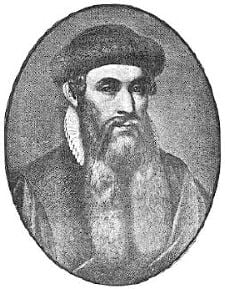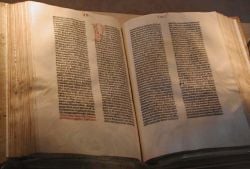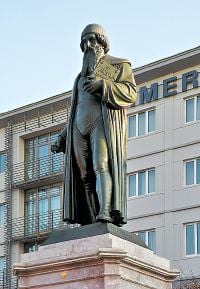Johannes Gutenberg
Johannes Gensfleisch zur Laden zum Gutenberg (c. 1398 – c. February 3, 1468) was a German goldsmith and inventor who achieved fame for his invention of the technology of printing with movable types during 1447. This technology included a type metal alloy and oil-based inks, a mold for casting type accurately, and a new kind of printing press based on presses used in wine-making in the Rhineland.
The exact origin of Gutenberg's first press is apparently unknown, and several authors cite his earliest presses as adaptations of heavier binding presses which were already in use. Tradition credits him with inventing movable type in Europe—an improvement on the block printing already in use there. By combining these elements into a production system, he allowed for the rapid printing of written materials, and an information explosion in Renaissance Europe. An iron printing press was first invented by Chae Yun-eui from Goryeo Dynasty (an ancient Korean nation, and also, the origin of the name "Korea") in 1234, over two hundred years ahead of Gutenberg's feat,[1] and the first movable type was invented by Chinese Bi Sheng between 1041 to 1048 C.E.
Gutenberg has often been credited as being the most influential and important person of all-time, with his invention occupying similar status. The A&E Network ranked him as such on their "People of the Millennium" countdown in 1999. Certainly, his invention earns him the distinction of being in the company of one of a relatively small number of women and men who changed history. Books no longer had to be hand written. Instead of only a privileged few having access to libraries, themselves scarce, any literate person could now seek to acquire knowledge. Without the printing press, universal education or education on a much larger scale would not have developed.
As more people gained an education, more accounts of events became available filtered through different perspectives, thus changing historical reconstruction itself. The Protestant Reformation stood on Gutenberg’s shoulders, since it largely depended on the availability, in vernacular languages, of the Bible so that people could read the scriptures for themselves and thus critique official interpretations that empowered the clergy and disempowered the laity. Gutenberg's famous "Gutenberg Bible" was the Latin Vulgate but it was not long before vernacular editions followed such as the first German Bible in 1466, the first Dutch bible (1477) and the first English New Testament, translated by William Tyndale in 1539. Martin Luther's appeared in 1534.
As a result of Gutenberg's invention, the world became much more interconnected, ideals about human dignity and rights and universal values spread enabling, in the twentieth century, the development of a global structure such as the United Nations and of humanitarian and international law.
Life
Gutenberg was born in the German city of Mainz, as the son of a patrician merchant named Friele Gensfleisch zur Laden, who adopted the surname "zum Gutenberg" after the name of the neighborhood where the family had moved. Gutenberg was born from a wealthy patrician family, who dated their lines of lineage back to the thirteenth century. Gutenberg's parents were goldsmiths and coin minters. Gutenberg's year of birth is not precisely known, but it was sometime between the years of 1394 and 1404.
John Lienhard, technology historian, wrote that "Most of Gutenberg's early life is a mystery. His father worked with the ecclesiastic mint. Gutenberg grew up knowing the trade of goldsmithing."[2]
In 1411, there was an uprising in Mainz against the patricians, and more than a hundred families were forced to leave. As a result, the Gutenbergs are thought to have moved to Eltville am Rhein (Alta Villa), where his mother had an inherited estate. According to historian Heinrich Wallau, "All that is known of his youth is that he was not in Mainz in 1430. It is presumed that he migrated for political reasons to Strasbourg, where the family probably had connections."[3] He is assumed to have studied at the University of Erfurt, where there is a record of the enrollment of a student called Johannes de Altavilla in 1418—Altavilla is the Latin form of Eltville am Rhein.[4]
Nothing is now known of Gutenberg's life for the next fifteen years, but in March 1434, a letter by him indicates that he was living in Strasbourg, where he had some relatives on his mother's side. He also appears to have been a goldsmith member enrolled in the Strasbourg militia. In 1437, there is evidence that he was instructing a wealthy tradesman on polishing gems, but where he had acquired this knowledge is unknown. Following his father's death in 1419, he is mentioned in the inheritance proceedings.
Until at least 1444 Gutenberg lived in Strasbourg, most likely in the St. Arbogast parish. It was in Strasbourg in 1440 that he is said to have perfected and unveiled the secret of printing based on his research, mysteriously entitled Aventur und Kunst (enterprise and art). It is not clear what work he was engaged in, or whether some early trials with printing from movable type may have been conducted there. After this, there is a gap of four years in the record. In 1448, he was back in Mainz, where he took out a loan from his brother-in-law Arnold Gelthus, quite possibly for a printing press or related paraphernalia. By this date, Gutenberg may have been familiar with intaglio printing; it is claimed that he had worked on copper engravings with an artist known as the "Master of Playing Cards."[5]
By 1450, the press was in operation, and a German poem had been printed, possibly the first item to be printed there.[6] Gutenberg was able to convince the wealthy moneylender Johann Fust for a loan of 800 guilders. Peter Schöffer, who became Fust's son-in-law, also joined the enterprise. Schöffer had worked as a scribe in Paris and is believed to have designed some of the first typefaces.
Some time in 1456, there was a dispute between Gutenberg and Fust, and Fust demanded his money back, accusing Gutenberg of misusing the funds. Fust sued at the archbishop's court. A November 1455 legal document records that there was a partnership for a "project of the books," the funds for which Gutenberg had used for other purposes, according to Fust. The court decided in favor of Fust, giving him control over the Bible printing workshop and half of all printed Bibles.
Thus Gutenberg was effectively bankrupt, but it appears he retained (or restarted) a small printing shop, and participated in the printing of a Bible in the town of Bamberg around 1459, for which he seems at least to have supplied the type. But since his printed books never carry his name or a date, it is difficult to be certain, and there is consequently a considerable scholarly debate on this subject. It is also possible that the large Catholicon dictionary, 300 copies of 754 pages, printed in Mainz in 1460, was executed in his workshop.
Meanwhile, the Fust–Schöffer shop was the first in Europe to bring out a book with the printer's name and date, the Mainz Psalter of August 1457, and while proudly proclaiming the mechanical process by which it had been produced, it made no mention of Gutenberg.
In 1462, during the devastating Mainz Diocesan Feud, Mainz was sacked by archbishop Adolph von Nassau, and Gutenberg was exiled. An old man by now, he moved to Eltville.
In January 1465, Gutenberg's achievements were recognized and he was given the title Hofmann (gentleman of the court) by von Nassau. This honor included a stipend, an annual court outfit, as well as 2,180 litres of grain and 2,000 liters of wine tax-free.[7] It is believed he may have moved back to Mainz around this time, but this is not certain.
Gutenberg died in 1468 and was buried in the Franciscan church at Mainz, his contributions largely unknown. This church and the cemetery were later destroyed, and Gutenberg's grave is now lost.[7]
Printing: the Invention of Movable Type in Europe
Block printing, whereby individual sheets of paper were pressed into wooden blocks with the text and illustrations carved into them, was first recorded in Chinese history, and was in use in East Asia long before Gutenberg. By the twelfth and thirteenth centuries, many Chinese libraries contained tens of thousands of printed books. The Chinese and Koreans knew about movable metal type at the time, but because of the complexity of the movable type printing it was not as widely used as in Renaissance Europe.
It is not clear whether Gutenberg knew of these existing techniques, or invented them independently, although the former is considered unlikely because of the substantial differences in technique. Some also claim that the Dutchman Laurens Janszoon Coster was the first European to invent movable type.
Gutenberg certainly introduced efficient methods into book production, leading to a boom in the production of texts in Europe—in large part, owing to the popularity of the Gutenberg Bibles, the first mass-produced work, starting on February 23, 1455. Even so, Gutenberg was a poor businessman, and made little money from his printing system.
Gutenberg began experimenting with metal typography after he had moved from his native town of Mainz to Strasbourg (then in Germany, now France) around 1430. Knowing that wood-block type involved a great deal of time and expense to reproduce, because it had to be hand-carved, Gutenberg concluded that metal type could be reproduced much more quickly once a single mold had been fashioned.
In 2004, Italian professor Bruno Fabbiani (from Turin Polytechnic) claimed that examination of the 42-line Bible revealed an overlapping of letters, suggesting that Gutenberg did not in fact use moveable type (individual cast characters) but rather used whole plates made from a system somewhat like our modern typewriters, whereby the letters were stamped into the plate and printed much as a woodcut would have been. Fabbiani created 30 experiments to demonstrate his claim at the Festival of Science in Genoa, but the theory inspired a great deal of consternation amongst scholars who boycotted the session and dismissed it as a stunt. James Clough later published an article in the Italian magazine Graphicus, which refuted the claims made by Fabbiani.
Gutenberg's printed works
In 1455, Gutenberg demonstrated the power of the printing press by selling copies of a two-volume Bible (Biblia Sacra) for 300 florins each. This was the equivalent of approximately three years' wages for an average clerk, but it was significantly cheaper than a handwritten Bible that could take a single monk 20 years to transcribe.
The one copy of the Biblia Sacra dated 1455 went to Paris, and was dated by the binder. As of 2003, the Gutenberg Bible census includes 11 complete copies vellum, one copy of the New Testament only on vellum, 48 substantially complete integral copies on paper, with another divided copy on paper, and an illuminated page (the Bagford fragment). The Gutenberg Bibles surviving today are sometimes called the oldest surviving books printed with movable type, although the oldest such surviving book is the Jikji, published in Korea in 1377. However, it is still notable, in that the print technology that produced the Gutenberg Bible marks the beginning of a cultural revolution unlike any that followed the development of print culture in Asia.
The Gutenberg Bible lacks many print features that modern readers are accustomed to, such as pagination, word spacing, indentations, and paragraph breaks.
The Bible was not Gutenberg's first printed work, for he produced approximately two dozen editions of Ars Minor, a portion of Aelius Donatus’s schoolbook on Latin grammar. The first edition is believed to have been printed between 1451 and 1452.
Legacy
Although Gutenberg was financially unsuccessful in his lifetime, his invention spread quickly, and news and books began to travel across Europe much faster than before. It fed the growing Renaissance, and since it greatly facilitated scientific publishing, it was a major catalyst for the later scientific revolution. The ability to produce many copies of a new book, and the appearance of Greek and Latin works in printed form was a major factor in the Reformation. Literacy also increased dramatically as a result. Gutenberg's inventions are sometimes considered the turning point from the Middle Ages to the Early Modern Period.
The term incunabulum refers to any western printed book produced between the first work of Gutenberg and the end of the year 1500.
There are many statues of Gutenberg in Germany; one of the more famous being a work by Bertel Thorvaldsen, in Mainz, home to the Gutenberg Museum.
The Johannes Gutenberg-University in Mainz is named in his honor.
The Gutenberg Galaxy and Project Gutenberg also commemorate Gutenberg's name.[8]
Notes
- ↑ Baek Sauk Gi, Woong-Jin-Wee-In-Jun-Gi (Woongjin Publishing, 1987), 61.
- ↑ John H. Lienhard, Johann Gutenberg The Engines of Our Ingenuity. Retrieved September 28, 2020.
- ↑ Heinrich Wallau, Johann Gutenberg The Catholic Encyclopedia, 1910. Retrieved September 28, 2020.
- ↑ Leonard Dudley, Information Revolutions in the History of the West (Edward Elgar Pub., 2008, ISBN 978-1847207906).
- ↑ Hellmut Lehmann-Haupt, Gutenberg and the Master of the Playing Cards (Yale University Press, 1966).
- ↑ John W. Klooster, Icons of Invention: The Makers of the Modern World from Gutenberg to Gates (Greenwood, 2009, ISBN 978-0313347474).
- ↑ 7.0 7.1 Tracy M. Sumner, How Did We Get the Bible? (Value Books, 2014).
- ↑ Project Gutenberg Retrieved September 28, 2020.
ReferencesISBN links support NWE through referral fees
- Borgman, Christine L. From Gutenberg to the Global Information Infrastructure: Access to Information in the Networked World. Cambridge, MA: MIT Press, 2000. New edition, 2003. ISBN 0262523450
- Dudley, Leonard. Information Revolutions in the History of the West. Edward Elgar Pub., 2008. ISBN 978-1847207906
- Eisenstein, Elizabeth L. The Printing Press as an Agent of Change. Cambridge: Cambridge University Press, 1980. ISBN 0521299551
- Hart, Michael H. The 100. New York: Carol Publishing Group, 1992. ISBN 0806513500
- Kapr, Albert and Douglas Martin. Johann Gutenberg: The Man and his Invention. Brookfield, VT: Scolar Press, 1996. ISBN 978-1859281147
- Klooster, John W. Icons of Invention: The Makers of the Modern World from Gutenberg to Gates. Greenwood, 2009. ISBN 978-0313347474
- Lehmann-Haupt, Hellmut. Gutenberg and the Master of the Playing Cards. Yale University Press, 1966.
- Man, John. Gutenberg: How One Man Remade the World with Words. New York: John Wiley & Sons, 2002. ISBN 978-0471218234
- Rees, Fran. Johannes Gutenberg: Inventor of the Printing Press. Minneapolis, MN: Compass Point Books, 2006. ISBN 978-0756509897
- Sumner, Tracy M. How Did We Get the Bible? Value Books, 2014.
External links
All links retrieved August 1, 2022.
- Gutenberg-Museum Mainz
- The Gutenberg Bible – Harry Ransom Center
Credits
New World Encyclopedia writers and editors rewrote and completed the Wikipedia article in accordance with New World Encyclopedia standards. This article abides by terms of the Creative Commons CC-by-sa 3.0 License (CC-by-sa), which may be used and disseminated with proper attribution. Credit is due under the terms of this license that can reference both the New World Encyclopedia contributors and the selfless volunteer contributors of the Wikimedia Foundation. To cite this article click here for a list of acceptable citing formats.The history of earlier contributions by wikipedians is accessible to researchers here:
The history of this article since it was imported to New World Encyclopedia:
Note: Some restrictions may apply to use of individual images which are separately licensed.


